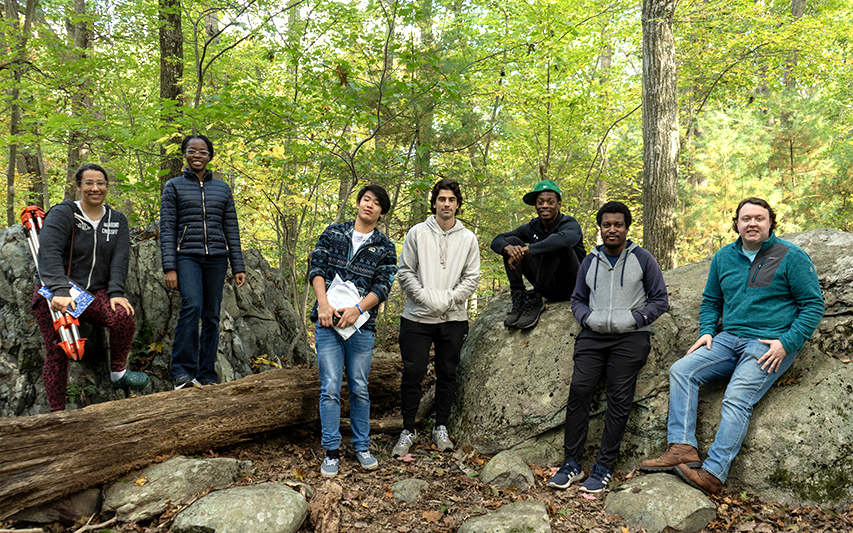Dr. Nate Lanning Uses Hands-on Learning, and Curry’s Campus, to Teach Students about Biodiversity

TOPICS:
By Jana F. Brown
How does human influence impact local tree species? Led by Dr. Nate Lanning, an associate lecturer in Curry’s Department of Natural Sciences and Mathematics, students studying environmental science set out to answer that question. In a lab that involved an assessment of biodiversity, changes in landscape structure, and tree core sampling, Lanning and his charges compared tree species at Houghton’s Pond and on the Curry campus.
“The lab was designed to help students visualize this human influence,” explains Lanning, who earned his Ph.D. in oceanography from Texas A&M. “The goal was to look at the same parameters at the pond and at a forest next to the North Campus Residence Hall to compare the species composition.”
The working hypothesis was that human impact would show a decreased number of tree species in the more traveled locations on campus. Meanwhile, Lanning and his students expected Houghton’s Pond to show an ability to host a more diverse biological community. “That’s exactly what we found,” Lanning says.
One surprise in the tree coring segment of the lab was that students discovered much younger trees near the pond versus more mature trees at the heart of campus. Tree coring indicated species ranging in age from two to 64 years old.
A Buffalo, New York, native, Lanning is a first-year lecturer at Curry who is also a postdoctoral research associate at MIT, where he studies the origin and movement of lead in the Southern Ocean and around Antarctica using isotopes. Lanning describes himself as a “trace metal biogeochemist,” which means he primarily works with heavy metals, including iron and lead, within the marine environment.
“The reason we care about heavy metals is that, while some of them act as key elements within biological functions, others have harmful impacts on the environment,” Lanning explains. “Some organisms make their own food and require these elements in small concentrations for photosynthesis. When in high concentration, these elements can be quite deleterious to the environment and can impact organismal health. Considering that human health is a major concern, and that the water cycle transports water across the globe, we want to make sure our oceans are clean.”
In his early years of discovering science, Lanning became obsessed with marine biology, particularly the study of whales, after his first encounters with orcas during visits to MarineLand on the Ontario side of Niagara Falls. In his undergraduate work at the University of New Haven, Lanning’s scientific path evolved to incorporate chemistry, partially due to an aversion to the smell of ground-down algae. But Lanning did not abandon algae altogether. He began studying toxic heavy metals for a research project in New Haven Harbor after his first year of college. In the project, he was looking at how algae can take copper from the water and clean it up naturally through a process called bioremediation.
“I really fell in love with copper and studying how toxic it can be,” Lanning recalls. “When I realized you could study more metals in the ocean, I decided I wanted to do this forever.”
Bioremediation is a topic Lanning also discusses with his students in ENVS 2215, the lecture and lab class he teaches in the fall semester. By introducing his students to the environment around them, notably on the Curry campus, Lanning aspires to help them gain a broader perspective of the different biological, chemical, and geological phenomena that surround them on a daily basis, making them aware of how humans influence the natural environment.
Lanning is grateful for the opportunity to share his knowledge with students at Curry. When he accepted his postdoc position at MIT, he knew he also wanted to teach. He sent emails to many institutions of higher learning in the Greater Boston area — his first response came from Dr. Jessica Fry, co-chair of the Department of Natural Sciences and Mathematics.
“Curry wasn’t just going to let me teach environmental science,” Lanning says, “they were going to allow me to develop my own course and take students out into the natural environment. My instruction is based on experiential learning and providing my students hands-on opportunities in the field. I cannot thank Curry enough for letting me help my students become the next generation of environmental stewards.”
